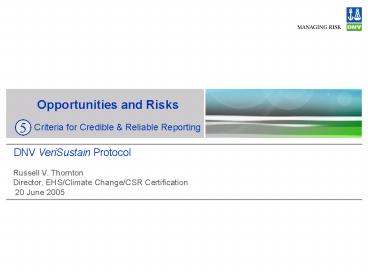DNV VeriSustain Protocol - PowerPoint PPT Presentation
1 / 17
Title:
DNV VeriSustain Protocol
Description:
No. years of performance data. Future targets. Re-statements ... Impact and risk analysis performed. Other indicators (whole picture) ... – PowerPoint PPT presentation
Number of Views:178
Avg rating:3.0/5.0
Title: DNV VeriSustain Protocol
1
5
Opportunities and Risks
Criteria for Credible Reliable Reporting
- DNV VeriSustain Protocol
Russell V. Thornton Director, EHS/Climate
Change/CSR Certification 20 June 2005
2
Pale Blue Dot
3
A Sense of Obligation
Stephen Crane (1871-1900)
A Man Said to the Universe
A man said to the universe "Sir, I exist!
"However," replied the universe,
"The fact has not created in me
"A sense of obligation."
4
Opportunities and Risks
- Table of Contents
- Definitions reporting risk opportunities
- Models for Reducing the risk of reporting
- Make reporting more meaningful and reliable
- Five Essential Criteria
5
Definitions
- Risk the probability and severity of an
undesired event resulting from reporting. - Opportunities are proven chances for advancement
- Performance Measurable results
- Material What is important
- Audit/transaction test Independent documented
processto determine extent to which reporting
systems meet audit criteria set by the
organization and other requirements (ed sic)
6
Current Reporting Trends
Opportunity Risks
Standardization An accelerating shift towards
common reporting criteria (e.g., EMS, EIS, GRI,
IMSD, etc. ) Consolidation An energetic shake-out
of the concepts, content and language of
reporting and verification Regulation The
emergence of government mandates in support of
reporting Integration Growing attempts to merge
or blend systems (e.g., audits, reporting
systems, best practices, standards)
7
Opportunity and Risks
Managing in the Verge
System C OSHA, SARA ISO 14001/9001 QC
Operations _at__at__at__at__at_
System B Enhanced Reporting GRI, IMSD, etc.
O O O O OOOOOOO OOOOOOOOOOOOOOOOOOOOOOOO OOOO
OOOOOOOOOOO
X X X X X X XXXXX XXXXXXXX XXXXXXXX XXXXXXXXXXXX
O X_at_ _at__at__at_X O O XXOOXXXO
System A Financial Reporting Accounting
Systems SOX
Integration of systems and reporting allows
re-combinations and emergent properties to
develop leading to new, innovative and more
effective and efficient systems
8
Reporting Risk Evaluation Model
Deciding what is Material to Report?
Identify all sources of risk and stakeholders
Evaluate risk
Develop plan
Implement plan
No
No
No
No
Treat
Terminate
Tolerate
Transfer
Yes
Yes
Yes
Yes
Identify Work Set Standard (LCA)
Measure Conformance Evaluate results Correct
and change
Eliminate impact(s) or hazard
Divest product or service Insurance
Monitor and Review results
9
Opportunities and Risks
Business and stakeholders alike need to find a
way to evaluate what really matters most, and
focus more effort on those areas. Russ
Thornton March 2005
10
Opportunity and Risks
What is IMPORTANT (MATERIAL)?
11
Reporting Risk Control Framework
Understanding the Business of Reporting
Reporting Requirements
Business Objectives Strategies
Scope of Reporting
Impacts, Hazards, Risks
Understand data generation systems and identify
key risk areas
Understand control systems in place to manage
reporting risks
Identify areas of Residual Risk
Transaction Testing (internal or external)
IMPROVEMENT OPPORTUNITIES
Third-Party Verification
12
Essential Reporting Criteria
5
1
- Proper Reporting Boundaries
- Stakeholder consultation
- In line with corporate policy and vision
- Includes all relevant aspects and indirect
impacts - Effective processes to include long-term, forward
looking trends, and reporting cumulative data
13
Essential Reporting Criteria
5
2
- Reliability
- Degree of reliability is determined by site level
reporting - Data should be evaluated through calculating the
arithmetic weighted mean (or other method) to
assess the scores/data from individual sites
14
Essential Reporting Criteria
5
3
- Accuracy
- Data collection is integrated with daily
activities - Few, if any, procedural or technical errors
- Ambiguity is minimized and performance metrics
are clear
15
Essential Reporting Criteria
5
4
- Comparability
- No. years of performance data
- Future targets
- Re-statements
- Stated in absolute terms, and normalized where
appropriate - Use graphics and charts
16
Essential Reporting Criteria
5
5
- Neutrality
- Impact and risk analysis performed
- Other indicators (whole picture)
- Indicators factually based and unbiased
- Aggregation done in a manner that does not
jeopardize strengths or create weaknesses
17
Thank you for your kind attention































